Tensereum emerges as a pioneering platform by merging blockchain technology and artificial intelligence (AI) to address critical challenges and unlock new potential. We present a novel blockchain framework that transcends traditional cryptocurrency mining paradigms by introducing the Proof-of-AI mining mechanism. The phased roadmap for Tensereum highlights key milestones and future developments that promise scalability, network optimization, and long-term sustainability. Additionally, it identifies and addresses potential market and technical risks, implementing strategies to mitigate them effectively. The tokenomics of Tensereum are meticulously structured to encourage long-term stability and growth, offering a sustainable economic model for the platform. We set forth a comprehensive governance structure and community involvement strategy to ensure decentralized decision-making and foster a robust, collaborative ecosystem. Our vision is to establish a platform where blockchain technology not only supports the growth of AI, but also contributes significantly to various sectors, driving technological advancement and innovation.
INTRODUCTIONOur mission is to revolutionize the blockchain mining landscape by introducing a model where computational power is used for validating transactions as well as conducting AI-driven tasks with real-world applications and value. The aim of Tensereum is to create a symbiotic ecosystem such that both miners and AI practitioners benefit. Miners will receive rewards for contributing their computational resources and AI practitioners gain access to a decentralized and robust computing network.
Blockchain technology and AI converge to form Tensereum; fostering a new era of innovation, efficiency, and sustainability. We envision a future where Tensereum becomes a cornerstone technology that not only supports the growth of AI but also contributes significantly to sectors such as healthcare, finance, and education through AI-driven solutions.
Two key observations motivated the inception of Tensereum:
1 . Environmental Concerns of Traditional Mining: Traditional cryptocurrency mining in networks like Bitcoin and Ethereum requires massive amounts of computational power, leading to high energy consumption and environmental concerns.
The carbon footprint (amount of carbon compounds emitted) of cryptocurrency mining loads () is defined as the difference between the system-wide total carbon emission of the base system () and the carbon emission of the system without mining loads () [1]:
Equation 1: Carbon Footprint of Cryptocurrency Mining Loads
One may note that this equation is generated as a simulation. The assumptions and simplifications for this simulation include [1]:
- Assuming “high accuracy of load and renewable generation forecasts”
- Only considering “cryptocurrency mining loads with no flexibility or price-response flexibility for simulation”
- Assuming “generation states in an optimal UC solution are not affected by the mining load behavior”
The carbon footprint per unit energy consumption of system loads () and cryptocurrency mining loads () may be defined with variables representing the system-wide total carbon emission of the base system (), active power output of generator “i” at hour “h” on day “d” in the base system (), and active power output of generator “i” at hour “h” on day “d” in the system with mining load ( ). The total number of buses () and start and end dates ( and ) are featured as bounds for the sums in the equation with indices of generator (), hour (), and day () [1]:
Equation 2: Carbon Footprint per Energy Consumption of System Loads
Equation 3: Carbon Footprint per Energy Consumption of Cryptocurrency Mining Loads
The energy required to mine a cryptocoin is estimated to range from 661.36-1449 kWh, whereas the estimated annual energy cost of cryptocurrency mining is approximately 131 TWh which exceeds the amount of electricity used by some countries [3].
- Tensereum addresses the high energy consumption issue by redirecting these computational efforts toward AI processes, which are inherently more productive and environmentally friendly.
2 . Underutilized AI Potential: Despite rapid advancements in AI, a significant gap in accessibility to computational resources for training and running AI models remains, especially for individual researchers and small enterprises.
- Tensereum aims to democratize access to these resources, allowing for wider participation and innovation in the AI field.
By tackling these issues, Tensereum proposes a more sustainable and ethical approach to blockchain mining while creating a platform for the practical and beneficial use of AI, driving both fields forward in a mutually beneficial manner.
SOLUTION OVERVIEW CORE CONCEPT AND INNOVATIONTensereum introduces a model that blends the capabilities of artificial intelligence (AI) with the decentralized nature of blockchain. This fusion manifests in the Proof-of-AI mining model, where the traditional blockchain mining process is transformed into a system of AI task execution. Miners in Tensereum contribute their computational power not for solving arbitrary cryptographic puzzles but for performing valuable AI-driven tasks, creating a direct impact in various sectors.
The innovation of Tensereum lies in its unique utilization of blockchain technology for practical and beneficial purposes. Instead of the often criticized energy-intensive traditional mining methods, Tensereum is built around the productive use of AI. This makes the mining process more environmentally sustainable while adding a layer of utility and value creation unseen in most existing blockchain models.
ROADMAPThe roadmap for Tensereum is structured as a phased development plan, outlining key milestones and future developments. This roadmap is designed to guide the project through various stages of growth and innovation, ensuring that each phase builds upon the last to achieve the overarching vision of Tensereum.
Figure 1: Phase 0-5 Objectives
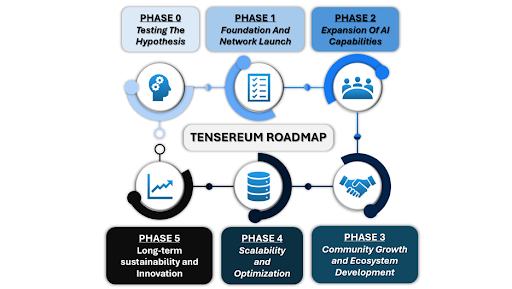
Phase 0: Testing the hypothesis
- MVP components launch in Testnet
- Tokensale at launchpads
- Testing integrations and business flows
- Security audit
- Tensereum Testnet launch
Phase 1: Foundation and Network Launch
- Development of the core blockchain infrastructure.
- Implementation of the Proof-of-AI mining mechanism.
- Initial distribution of the premined Tensereum tokens.
- Launch of the Tensereum mainnet.
Phase 2: Expansion of AI Capabilities
- Integration of a wider range of AI models and tasks.
- Enhancement of model training and deployment processes.
- Expansion of the network to include more miners and AI practitioners.
- Introduction of cross-validation and benchmarking systems.
Phase 3: Community Growth and Ecosystem Development
- Fostering a robust community of developers, researchers, and users.
- Implementing governance and reward structures for community contributions.
- Establishing partnerships with academic and industry leaders.
- Enhancing user interfaces and experience for broader accessibility.
Phase 4: Scalability and Optimization
- Introducing scalability solutions like sharding or layer-2 protocols.
- Optimizing network efficiency and transaction processing speeds.
- Conducting comprehensive security audits and addressing any emerging challenges.
Phase 5: Long-term Sustainability and Innovation
- Continuing to innovate in AI and blockchain integration.
- Adapting to technological advancements and market changes.
- Exploring new use cases and applications in various sectors.
- Sustaining the ecosystem through ongoing development and community support.
Figure 2: Short, Mid, and Long-Term Development Timeline
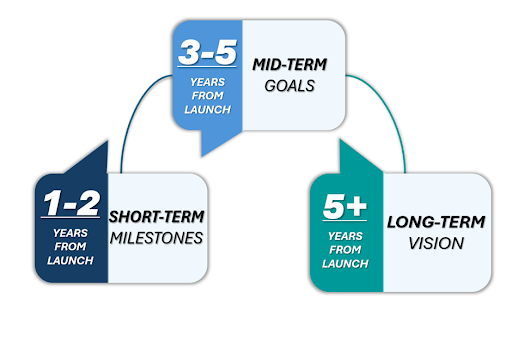
Short-term Milestones (1-2 years)
- Successful mainnet launch.
- Establishment of initial partnerships and user base.
- Achievement of predetermined network performance and participation targets.
Mid-term Goals (3-5 years)
- Widespread adoption and recognition in the AI and blockchain communities.
- Significant contributions to AI research and development.
- Expansion of the Tensereum ecosystem with diverse applications and services.
Long-term Vision (5+ years)
- Becoming a leading platform for decentralized AI services.
- Continuous evolution to stay at the forefront of blockchain and AI technology.
- Making substantial impacts in various fields through Tensereum’s AI capabilities.
Central to Tensereum's innovation is the Proof-of-AI model, a novel concept in blockchain mining. This model redefines the traditional mining process, shifting the focus from computational puzzles to executing AI tasks. In Tensereum, miners contribute not just their computing power but also their AI capabilities, executing real-world AI tasks sourced from users across various industries.
The Proof-of-AI model offers several advantages:
- Practical and Value-Driven Mining: Unlike traditional mining methods that rely on solving arbitrary mathematical problems, Proof-of-AI focuses on performing useful and practical AI tasks, thereby creating tangible value.
- Energy Efficiency and Sustainability: By aligning mining activities with AI tasks, Tensereum promotes a more energy-efficient approach than traditional mining models, contributing to environmental sustainability.
- Fostering AI Innovation: This model democratizes access to AI resources, allowing researchers, developers, and businesses to leverage the collective power of decentralized AI, spurring innovation and advancement in the field.
- Dynamic Ecosystem: Integrating user-paid tasks and network emissions creates a dynamic and self-sustaining ecosystem, encouraging continuous growth and participation.
Traditional Cryptocurrencies: Unlike traditional cryptocurrencies like Bitcoin or Ethereum, which use Proof-of-Work (PoW) or Proof-of-Stake (PoS) mechanisms primarily focused on transaction validation and ledger maintenance, Tensereum leverages computational resources for AI processing. This approach shifts the focus from energy consumption to value creation, addressing the criticism of resource waste associated with traditional cryptocurrency mining.
Bittensor: Tensereum shares some similarities with projects like Bittensor, especially in utilizing decentralized networks for data processing. However, while Bittensor focuses on creating a decentralized network for machine learning models, Tensereum integrates these capabilities into the blockchain mining process itself. This integration not only incentivizes the participation of miners but also provides a streamlined platform for users seeking AI services.
Key Features- Proof-of-AI Mining Model: The unique mining process focuses on executing AI tasks, aligning miners' incentives with productive and valuable computation.
- Token Rewards for Practical Tasks: Miners are rewarded for the actual AI tasks they perform, creating a direct correlation between work done and rewards earned.
- Democratic Access to AI Resources: By decentralizing AI capabilities, Tensereum provides access to computational resources for AI tasks to a broader audience, including small-scale researchers and developers.
- Environmental Sustainability: By moving away from traditional mining methods, Tensereum significantly reduces the environmental impact associated with blockchain mining.
- Stimulating AI Advancements: The platform acts as a catalyst for AI research and development, promoting innovation across various fields.
- Creating a Self-Sustaining Ecosystem: The combination of user-paid tasks and network emissions ensures a balanced and self-sustaining economic model.
Tensereum's core concept, innovative approach, and unique features set it apart from traditional cryptocurrencies and projects like Bittensor. By harnessing the power of AI within the blockchain space, Tensereum is poised to redefine the landscape of decentralized computing and cryptocurrency mining.
SOLUTION SPECIFICATIONS TECHNICAL ARCHITECTURETensereum's blockchain infrastructure is designed to support a high level of scalability, security, and efficiency. This infrastructure is pivotal in managing the Proof-of-AI mining process, AI model integration, and transaction handling within the network.
- Consensus Mechanism: Tensereum employs a modified consensus mechanism tailored to the Proof-of-AI model. This mechanism validates transactions and verifies the completion and correctness of AI tasks performed by miners.
- Scalability Solutions: Solutions such as sharding or layer-2 protocols allow the infrastructure to handle a large number of transactions and AI task validations efficiently.
- Smart Contract Capability: Smart contracts enable complex agreements and automated execution of tasks within the network, which are vital for managing AI task distribution, validation, and rewards.
Integrating AI models into the Tensereum blockchain involves several key considerations to ensure efficiency and effectiveness:
- Model Hosting and Execution: By providing a framework for hosting and executing a variety of AI models, the blockchain allows miners to choose which AI tasks to perform based on computational resources and expertise.
- Standardization of AI Tasks: A standardized format for AI tasks ensures compatibility and uniformity across the network, facilitating easier execution and validation.
- Performance Metrics: Clear performance metrics for AI tasks ensure that miners are accurately rewarded based on the complexity and value of the tasks they complete.
In dealing with AI tasks, especially those involving sensitive data, Tensereum prioritizes data privacy and security:
- Data Encryption: Advanced encryption techniques protect data during transmission and processing within the network.
- Privacy-Preserving AI Techniques: Methods such as federated learning and differential privacy enable AI model training and execution without compromising data privacy.
- Data Rights and Ownership: Clear policies regarding data rights and ownership ensure that users' data is used ethically and legally within the Tensereum ecosystem.
Zero-knowledge proofs (ZKPs) play a crucial role in enhancing security and privacy within Tensereum:
- ZKP for Task Validation: ZKPs validate the completion and accuracy of AI tasks without revealing the underlying data or the specifics of the model, maintaining privacy and security.
- Security Against Malicious Actors: Robust security protocols, including regular security audits and real-time monitoring, protect against malicious activities and potential vulnerabilities.
- Network Resilience: The network architecture is designed to be resilient against common blockchain threats, such as 51% attacks, ensuring the integrity and stability of the Tensereum platform.
Through its advanced blockchain infrastructure, AI model integration, and a strong focus on data handling and privacy, Tensereum establishes itself as a secure and efficient platform. The incorporation of zero-knowledge proofs and other security measures further solidifies its position as a trustworthy and pioneering project in the intersection of AI and blockchain.
AI-POWERED MINING MECHANISMAI mining in Tensereum revolutionizes the traditional concept of cryptocurrency mining by focusing on AI-driven tasks. This approach leverages the network's computational power for practical AI applications, contributing real-world value.
- Task Selection and Execution: Miners in the Tensereum network select AI tasks based on their capabilities. These tasks, sourced from a wide range of fields, are executed to provide AI solutions and services.
- Handling Low Task Volumes: In scenarios where there is a shortage of user-paid tasks, miners can still participate by emitting empty blocks. These blocks contain minimal transactions and are rewarded with a smaller number of tokens. This mechanism is designed to maintain network integrity and prevent wasteful electricity consumption.
Optimizing AI models for maximum efficiency is a cornerstone of Tensereum's approach, ensuring competitiveness and sustainability.
- Efficient AI Models: Ongoing optimization of AI models using advanced algorithms and compression techniques enhances processing efficiency.
- Energy-Efficient Mining: Energy-efficient computing practices minimize the environmental impact in keeping with Tensereum's commitment to sustainability.
Effective distribution of tasks and resources is key to the smooth functioning of the Tensereum network.
- Adaptive Load Balancing: Algorithms are implemented to evenly distribute both AI tasks and the creation of empty blocks across the network, optimizing resource use and preventing bottlenecks.
- Strategic Resource Allocation: Resources are allocated based on network demand, task requirements, and miner capabilities to ensure efficient completion of AI tasks and minimal wastage.
- Scalability and Flexibility: The network is designed to scale and adapt efficiently to varying levels of usage, maintaining performance and effectiveness even with fluctuating task volumes.
Through its innovative AI-powered mining mechanism, Tensereum redefines the blockchain mining process, aligning it with productive AI tasks and real-world applications. This approach, combined with a carefully designed incentive system and emphasis on energy efficiency and optimization, positions Tensereum as a pioneering platform at the intersection of blockchain and artificial intelligence.
TOKENOMICS Token Utility and DistributionFigure 3: Token Distribution Pie Chart
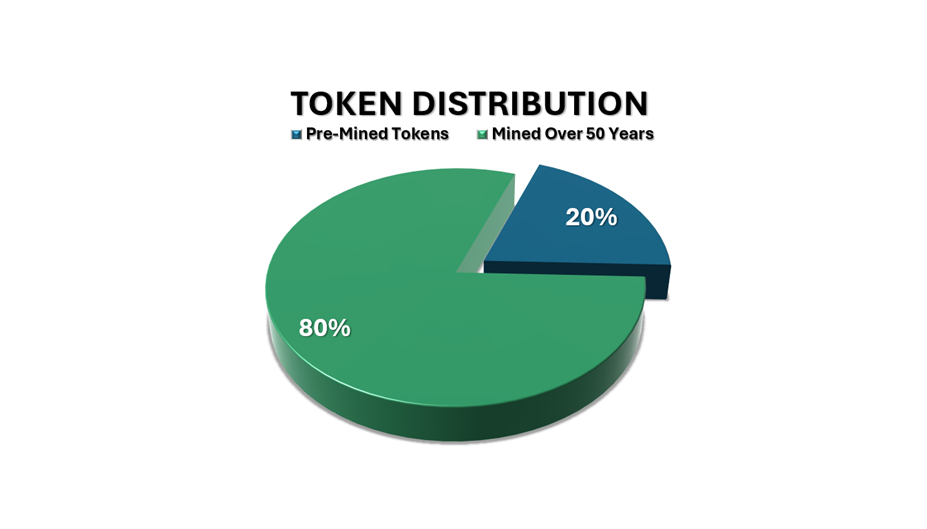
- Initial Distribution: Tensereum will have 20% of its total token supply premined. This allocation is intended for initial funding, development, marketing, and establishing a reserve for the network. This approach mirrors Ethereum's model, providing necessary resources for the early stages of the network's life.
- Long-Term Mining Process: The remaining 80% of Tensereum tokens are set to be mined over a period of 50 years. This long-term view ensures a steady supply of tokens, contributing to the network's health and longevity.
- Halving Mechanism: Following the concept popularized by Bitcoin, Tensereum incorporates a halving event every 2 years. This means that the rate at which new tokens are generated and rewarded to miners will be halved every 2 years, reducing the influx of new tokens into the market and creating deflationary pressure to support the token's value over time.
Figure 4: Halving Mechanism
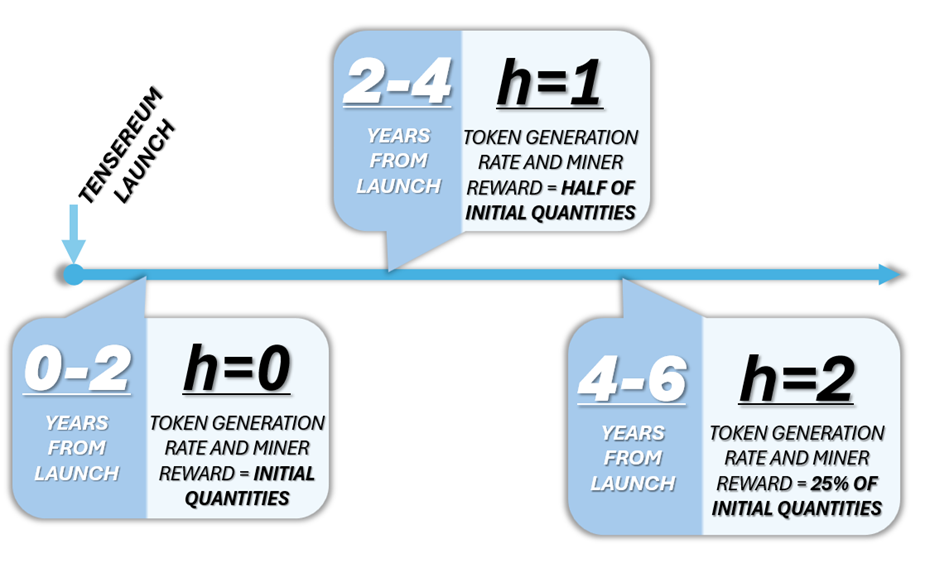
The relative new token generation rate and miner reward percentage () is defined relative to the initial new token generation rate and miner reward percentage () after “h” halving events. One may note that since it represents 100% as the initial rate and reward percentage.
Equation 4: New Token Generation Rate and Miner Reward Percentage after “h” Halving Events
Equation 4 may be plotted over “h” values of 0-7 representing the relative token generation rate and miner reward percentage over 7 halving events (14 years). The number of years was calculated from the number of halving events () by multiplying the number of halving events by 2 years per halving event:
Figure 5: Relative Token Generation Rate and Miner Reward Percentage Over Time
(From Equation 4)
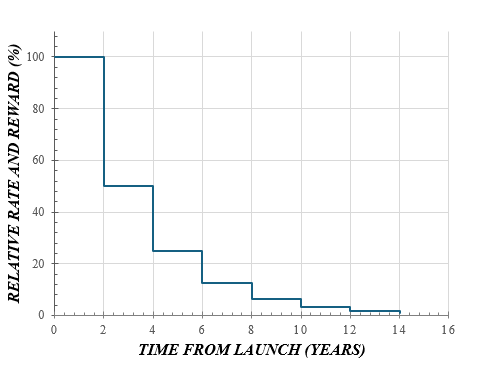
The new token generation rate () and miner reward quantities () are defined as the product of the relative new token generation rate and miner reward percentage (), the initial token generation rate (), and initial miner reward (). Since the variable is dimensionless, the resulting quantities keep the units of the initial rate and reward variables.
Equation 5(a,b): New Token Generation Rate (a) and Miner Reward Quantities (b)
Equation 5 may be rewritten with only initial values by combining Equation 4 and 5(a,b).
Equation 6(a,b): Token Generation Rate (a) and Miner Reward Quantities (b) from Initial Values
Transaction and Service Fees- Transaction Fees: Transactions on the Tensereum network, including token transfers and payments for AI services, incur a fee. These fees are used for network maintenance and development and to reward participants engaged in governance and network operations.
- AI Service Fees: Users submitting AI tasks to the network pay fees in Tensereum tokens. These fees are then distributed to miners, aligning the cost of AI services with the network's economic model.
- Dynamic Fee Adjustment: The network employs a dynamic fee adjustment mechanism to ensure that transaction costs are fair and reflect the network's current state, including demand and congestion levels.
Figure 6:Tensereum Transaction Flowchart
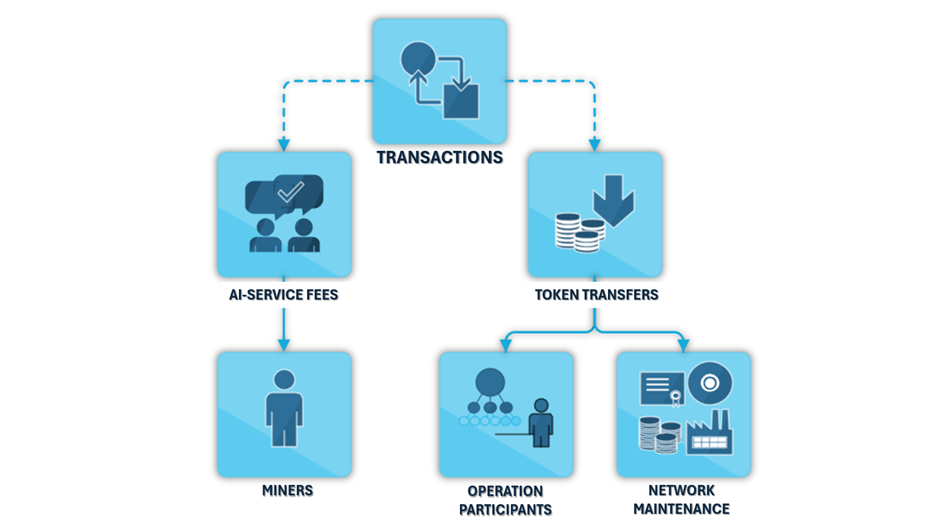
The tokenomics model of Tensereum is designed with a long-term perspective, ensuring a balanced and sustainable approach to token distribution and mining. The premined portion provides foundational support for the network's initial phase, while the extended mining period and halving events are structured to encourage ongoing participation and investment in the network's future.
RISK ANALYSISIn the development and operation of Tensereum, it is crucial to identify potential risks and implement strategies to mitigate them. This section addresses the key market and technical risks associated with the project and outlines the mitigation strategies to safeguard the platform and its users.
Market RisksAdoption and Market Penetration: One of the primary risks is the challenge of gaining widespread adoption. Tensereum competes in a space with established blockchain and AI platforms.
Mitigation: To address this, Tensereum will focus on unique value propositions, such as its innovative AI-powered mining mechanism and practical applications in various industries.
Volatility of Cryptocurrency Markets: The inherent volatility in cryptocurrency markets can impact the value and stability of Tensereum tokens.
Mitigation: Diversifying the use cases of Tensereum tokens and implementing mechanisms like token staking will provide more stability to the token's value.
Regulatory Changes: Changes in regulatory landscapes across different regions can pose challenges.
Mitigation: Staying proactive in regulatory compliance and engaging with policymakers will ensure Tensereum aligns with regulatory requirements.
Technical RisksNetwork Security Risks: As with any blockchain platform, there is a risk of security breaches and attacks.
Mitigation: Implementing state-of-the-art security protocols, conducting regular security audits, and fostering a community-based approach will allow us to identify and address vulnerabilities.
Scalability Challenges: As the platform grows, scalability could become an issue, impacting transaction speeds and efficiency.
Mitigation: Scalability is being planned from the outset, considering technologies like sharding or subnets solutions and continuous network optimization.
AI Model Integrity: Ensuring the accuracy and reliability of AI models is critical.
Mitigation: The integrity of the AI models will be maintained through rigorous model testing, validation procedures, and community-driven oversights.
Mitigation StrategiesIn addition to specific measures for market and technical risks, Tensereum will implement a comprehensive risk management framework:
Continuous Monitoring and Assessment: Regularly monitoring the market trends and technological developments to anticipate and react to risks proactively.
Community and Stakeholder Engagement: Engaging with the Tensereum community and stakeholders for feedback, suggestions, and alerts on potential risks.
Adaptive and Agile Development: Maintaining an adaptive approach to development, allowing for quick responses to changing market conditions, user needs, and technological advancements.
INCENTIVES Earnings for MinersMiners in the Tensereum network earn rewards in two primary ways:
1 . User-Paid Tasks: Users who require AI services – such as data analysis, machine learning model training, or complex computations – can submit their tasks to the Tensereum network. Miners then select and execute these tasks, receiving payment in Tensereum tokens directly from the users. This creates a direct value exchange, where users pay for the AI services they need, and miners are rewarded for providing computational and AI processing power. 2 . Network Emission Rewards: In addition to earnings from user-paid tasks, miners also receive rewards from the network itself. Periodically, new Tensereum tokens are released into the network as a reward for miners. This emission of new coins is carefully regulated to maintain the token's value and incentivize continuous participation in the network. The rate and criteria of these emissions are determined by the network's governance protocols, ensuring a fair and sustainable distribution of rewards.
Incentive StructureTensereum's incentive model is tailored to ensure fair compensation for miners, fostering a sustainable and efficient AI task completion environment.
Task-Based Rewards: Miners earn Tensereum tokens for successfully completing AI tasks, aligning their compensation with their contribution to the network. The introduction of a halving mechanism ensures that rewards are distributed sustainably over a prolonged period, incentivizing long-term participation.
Rewards for Empty Blocks: In periods of low task availability, miners emitting empty blocks receive minimal rewards. This ensures a base level of earnings, discouraging spam and unnecessary energy expenditure.
Performance Incentives: Additional rewards are offered based on the quality and efficiency of task execution, promoting a high standard of work among miners.
Staking and Participation Incentives: Apart from mining rewards, participants can also earn tokens through staking mechanisms and active involvement in governance and network support activities.
Figure 7: Miner Earnings Flowchart
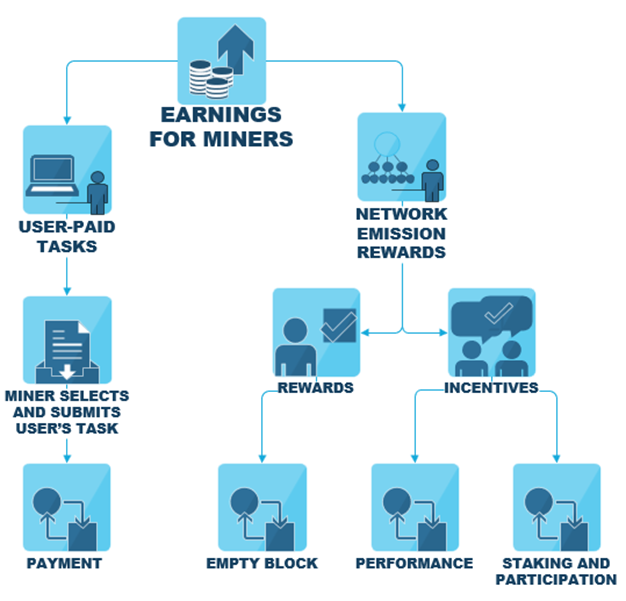
The success of Tensereum hinges not just on its technological prowess but also on robust governance and an engaged community. This section outlines the governance structure of Tensereum, the role of community involvement, and the importance of adhering to policies and regulatory complianc
Governance StructureDecentralized Governance Model: Tensereum adopts a decentralized governance model, empowering token holders with voting rights on key decisions. This includes decisions on network upgrades, tokenomics changes, and the allocation of resources.
Transparent Decision-Making Process: All proposals and decisions are made transparently and are accessible to the entire community. This ensures that the governance process is open and accountable.
Role of Governance Tokens: Holders of Tensereum governance tokens can propose changes, vote on various initiatives, and participate in the direction and development of the network.
Community Involvement and ContributionCommunity-Driven Development: Tensereum places a strong emphasis on community contributions. Developers, users, and supporters can contribute to the network's development, whether through coding, providing feedback, or participating in community discussions.
Rewarding Contributions: Active contributors can be rewarded with Tensereum tokens, incentivizing ongoing involvement and innovation within the community.
Educational and Supportive Ecosystem: The platform fosters an educational environment, providing resources and support to encourage new users and developers to actively participate in the Tensereum ecosystem.
CONCLUSION USE CASESTensereum's unique integration of blockchain and AI opens up a multitude of use cases and applications across various sectors such as AI Model Training, Scientific Research, and Financial Predictive Models.
AI Model Training and Deployment- Decentralized Training: Tensereum allows for the decentralized training of AI models. By leveraging the distributed computational power of the network, Tensereum can facilitate the training of complex models that would otherwise require substantial resources.
- Model Deployment and Accessibility: Once trained, these models can be deployed within the Tensereum network, making them accessible to a broader audience. This democratizes access to cutting-edge AI technologies, particularly benefiting small businesses and individual developers who lack the resources for large-scale AI deployments.
- Data Processing for Research: Tensereum's network can be used to process large datasets for scientific research, ranging from genetics to climate science. This processing power can significantly accelerate research outcomes and discoveries.
- Collaborative Research Opportunities: The platform can facilitate collaborative research efforts, allowing scientists and researchers worldwide to contribute to and benefit from shared AI models and data analysis tools.
- Predictive Modeling: Tensereum can be instrumental in developing and running financial predictive models. These models can analyze market trends, assess investment risks, and predict asset price movements, providing valuable insights to investors and financial institutions.
- Market Analysis Tools: The network's AI capabilities can be harnessed to create sophisticated market analysis tools. These tools can process vast amounts of financial data to identify emerging trends, perform sentiment analysis, and offer real-time market insights.
The potential applications of Tensereum extend far beyond these examples. Its ability to harness decentralized AI and blockchain technology paves the way for innovative solutions across numerous fields. Whether it's enhancing scientific research, revolutionizing financial markets, or democratizing access to AI, Tensereum is poised to be a catalyst for change and advancement in many sectors.
OUR SUSTAINABLE FUTUREThe Tensereum platform emerges as a beacon of sustainable practices, efficiency, and practical utility in the blockchain sphere, fundamentally shifting the paradigm from mere transaction validation to the productive execution of AI tasks. This transformation symbolizes a significant leap towards environmental responsibility and the constructive use of computational resources.
The introduction of the Proof-of-AI mining mechanism within Tensereum marks a pivotal moment in blockchain history. It champions not only ecological mindfulness but also the democratization of AI, making advanced AI resources accessible to a broader spectrum of users and creators. This accessibility is paramount in catalyzing innovation and fostering inclusive growth across multiple sectors from scientific research to financial analysis.
Tensereum’s tokenomics approach to distribution and rewards is designed to ensure the long-term stability and growth of the ecosystem. The phased development plan, with clear milestones and future goals, underscores our commitment to continuous evolution and adaptability in this fast-paced digital age.
However, the journey of Tensereum is not a solitary one; it is a path that we endeavor to walk alongside a vibrant community of developers, researchers, investors, and enthusiasts. We invite you to join us in this groundbreaking journey as we explore the untapped potentials at the intersection of blockchain and AI. Your participation, whether as a contributor, a miner, a user, or an investor, is integral to shaping the Tensereum ecosystem and steering it towards a future replete with innovation and opportunities.
As we look towards the horizon, Tensereum stands ready to not only navigate but also illuminate the path forward in the digital landscape. The fusion of blockchain and AI through Tensereum is more than an advancement; it is a gateway to a new era of digital solutions that are sustainable, inclusive, and immensely impactful. Join us in this exciting venture as we pave the way for a smarter, more connected, and environmentally conscious digital future.
REFERENCES- [1] “High Resolution Modeling and Analysis of Cryptocurrency Mining’s Impact on Power Grids: Carbon Footprint, Reliability, and Electricity Price”. Download
- [2] “Physical and Economic Viability of Cryptocurrency Mining for Provision of Frequency Regulation: A Real-World Texas Case Study”. Download
- [3] “Energy Estimates Across Layers of Computing: From Devices to Large-Scale Applications in Machine Learning for Natural Language Processing, Scientific Computing, and Cryptocurrency Mining”. Download
